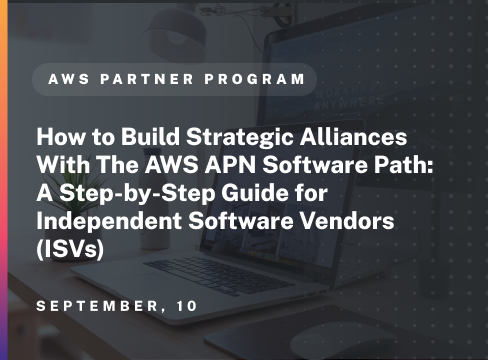Adopted from the APN Software Path Partner Handbook
If you’re leading partnerships at an ISV, you already know that building strategic alliances is one of the best ways to grow your business. And when it comes to forming those alliances, few platforms are as powerful as Amazon Web Services (AWS).
AWS has a whole setup through the AWS Partner Network (APN) to help ISVs build better solutions, get them in front of more customers, and boost sales.
In this guide, we’ll walk you through exactly how to use the APN Software Path to create solid strategic alliances to co-build, co-market, and co-sell your way to success with AWS.
The APN Software Path
In simple terms, the Software Path is designed to help ISVs build, market, and sell their solutions on AWS. You create a strategic alliance that allows both you and AWS succeed.
Check out all the AWS Partner Paths here.
At its core, the APN Software Path revolves around three pillars:
- Co-Build: You get access to AWS resources to develop and improve your software on AWS.
- Co-Market: AWS helps you market your solution to their customer base, giving you more visibility.
- Co-Sell: You and AWS team up to sell your solution to a broader audience, working together to close deals.
So why does this matter for your partnerships? The APN Software Path gives you access to a ton of benefits that can help your business grow, like:
- Technical expertise: AWS gives you the tools to ensure your solution is solid.
- Sales and marketing support: You get access to resources that help you reach more customers.
- AWS funding opportunities: AWS even offers potential funding to help with development and marketing.
Understanding these pillars is the first step in unlocking the power of strategic alliances through AWS.
Register and Enroll in the AWS Partner Network
Now that you know the APN Software Path, let’s start with the first actionable step: registering and enrolling. This is where your partnership with AWS officially kicks off, and it’s easier than you might think.
To register for the AWS Partner Network (APN), follow these steps:
- Create an account: Head to AWS Partner Central and sign up using your company email.
- Accept the Terms and Conditions: Once you’re in, you must agree to the APN terms.
- Set up your company profile: If your company doesn’t already have an account, AWS will create one, and you’ll be assigned as the Alliance Lead.
Once you’re registered, it’s time to enroll in the APN Software Path. Here’s how you do that:
- Log into Partner Central: Head back to the homepage and click the “Enroll in the Software Path” button.
- Update your profile: If you don’t see the Software Path option, update your account to show that your company offers software products.
- Pay the APN program fee: There’s a $2,500 annual fee to enroll, but AWS gives you $3,500 in promotional credits to help offset costs.
Enrolling sets the foundation for your strategic alliance with AWS. It’s your ticket to accessing the full range of resources AWS offers, from technical support to marketing tools.
Complete the Foundational Technical Review (FTR) to Confirm and Validate Your Solution
Once enrolled, the next major step is completing the Foundational Technical Review (FTR). This is a critical part of the process because it validates your solution, proving to AWS (and your customers) that your product meets their technical standards.
It’s a non-negotiable if you want to unlock advanced benefits and form a solid strategic alliance with AWS.
Here’s how you can get started with the FTR:
- Download the self-assessment template: AWS provides a self-assessment checklist that you’ll need to fill out. This covers everything from your software architecture to your security practices.
- Run a security report: Use AWS Security Hub or a similar tool to evaluate your solution against the CIS AWS Foundations Benchmark. This helps ensure that your product is secure and AWS-compliant.
After completing those steps, you’ll submit your solution for review. Here’s what you need to do:
- Log into Partner Central: Go to the “Build” section, find your product offering, and upload your completed self-assessment and security report.
- Submit for FTR: Once everything is uploaded, click “Request Foundational Technical Review.” Ensure all documents are in order because you can’t submit until everything is ready.
- Work with an AWS Partner Solutions Architect (PSA): AWS will assign a PSA to help guide you through any technical challenges during the review process.
Completing the FTR gets you to the next stage in the APN Software Path and gives your solution credibility. It tells AWS (and their customers) that your product is well-architected and ready for the big leagues, solidifying your strategic alliance with AWS.
Co-Build with AWS
Now that you’ve completed the Foundational Technical Review (FTR), you can start actively building your solution with AWS. This is where the Co-Build phase kicks in, and it’s all about leveraging AWS’s technical resources to refine and enhance your product.
There are three ways to co-build with AWS:
- AWS Well-Architected Framework: This framework provides best practices to help you design, deploy, and optimize your solution on AWS. It’s a crucial tool for ensuring your product is scalable, secure, and efficient.
- AWS TechShift: This program offers technical resources to help ISVs modernize and improve their software. It includes cloud readiness assessments, migration support, and access to AWS architects.
- SaaS Factory Tools: If you’re building SaaS products, AWS provides the SaaS Factory to help you streamline development. You’ll get access to technical guides, best practices, and SaaS-specific architecture support.
During this phase, it’s all about refining your product to meet AWS standards and stand out in the marketplace. Co-building with AWS makes your solution more robust, scalable, and ready to handle the needs of larger enterprise customers.
Listing on the AWS Marketplace
With your solution built and validated, it’s time to get it in front of customers. The best way to do that is by listing your product on the AWS Marketplace, a massive platform with over 1 million active customers. Listing on AWS Marketplace gives your solution visibility and lets you tap into AWS’ customer base and resources.
To get started:
- Register as a Marketplace seller: Before anything, you’ll need to register on the AWS Marketplace Management Portal (AMMP). This process includes submitting your company’s tax and banking information, so make sure all your details are ready.
- Choose your product delivery and pricing model: AWS supports a variety of models, including SaaS, AMI (Amazon Machine Images), and container-based solutions. You can also offer flexible pricing, including monthly, yearly, pay-as-you-go, or free trials. Decide what works best for your product and customers.
- Create a limited listing: Start by creating a limited AWS Marketplace listing that only you and your team can see. This lets you check that everything, from product descriptions to API integrations, works correctly before going live.
Once you’ve completed those steps, you can publish your solution for the world to see. Here’s how the publication process works:
- Integrate your solution: Depending on your product type, you may need to integrate with AWS billing APIs or other systems. AWS offers guides for different solution types, like SaaS, AMI, or containers, so follow the one that fits your product.
- Submit for approval: Once your product is ready, submit it for review by AWS’s Managed Catalog Operations team. They’ll check that everything meets their standards, and after approval, you can schedule a go-live date.
- Go live: Once approved, your product is officially listed on the AWS Marketplace, opening you up to a large customer base and potential co-selling opportunities.
This step puts your product on a trusted platform, allows customers to find and purchase your solution more efficiently, and opens the door to future collaboration opportunities with AWS. Now that you’re listed, you can fully leverage AWS’s go-to-market support to drive sales and grow your business.
Co-Marketing with AWS
AWS offers a variety of marketing tools and resources that can help you position your product in front of its massive customer base, making your strategic alliance even more powerful:
- Marketing Central: AWS’s Marketing Central is your go-to hub for pre-built, partner-ready marketing resources. Whether you need campaign templates, logos, or other marketing assets, this is where you can access everything to start promoting your solution.
- Virtual Partner Marketing Manager (vPMM): If you need extra guidance, request a vPMM through AWS’s Marketing Concierge Service. This dedicated marketing expert can help you craft and execute campaigns tailored to your product and audience.
- AWS Certified Speakers: Planning a webinar or event? AWS has a roster of certified speakers who can help bolster your marketing efforts. You can request an AWS expert to speak at your events, adding credibility and depth to your presentations.
AWS also offers various ways to help you get more visibility:
- Submit press releases: If you want to announce your solution or any new partnership with AWS, you can submit a press release for AWS’s approval. They’ll review it to ensure it aligns with their messaging, and once approved, your announcement can go live to a broader audience.
- Get social with AWS: AWS has a strong presence on LinkedIn, X (formerly Twitter), and YouTube. Tag AWS Partners or AWS Marketplace in your posts, and if your content showcases a clear AWS angle, they might engage with or share your post. This can help amplify your reach.
Co-marketing with AWS positions your solution in front of AWS account teams and customers, creating more opportunities for collaboration and customer acquisition.
Co-Selling with AWS
Now that your product is live and your marketing efforts are in motion, it’s time to focus on Co-Selling with AWS. This phase is where the real power of your strategic alliance with AWS starts to shine.
AWS’s sales teams can help you reach customers, close deals, and drive revenue by working together to co-sell your solution.
Here’s how you can start co-selling with AWS:
- Leverage the APN Customer Engagement (ACE) Program: The ACE Program allows you to share sales opportunities with AWS account teams. By submitting opportunities through the ACE Pipeline Manager, you can build mindshare with AWS, which helps the sales teams understand how your solution solves customer problems.
- Submit opportunities in the ACE Portal: Start by logging into Partner Central and navigating to the “Opportunity Management” section under the “Sell” tab. From there, you can submit opportunities to AWS account teams. Be sure to provide detailed descriptions, including the customer’s pain points, your recommended solution, and the expected AWS Monthly Recurring Revenue (MRR).
- Collaborate with AWS account teams: After submitting opportunities, they will help you grow and enrich them. Ensure that strong relationships are fostered with these teams by keeping them updated and asking for support in specific industries or regions where your product can make the most impact.
Another powerful co-selling tool is AWS Marketplace Private Offers.
AWS allows you to negotiate custom pricing and contract terms for specific customers through Marketplace Private Offers (MPPOs). Whether your customers need flexible payment schedules or annual pricing, private offers let you tailor solutions to meet their needs.
AWS Marketplace also supports Channel Partner Private Offers (CPPOs), where you can collaborate with AWS resellers to scale your co-selling efforts. These partners already have strong customer relationships, making positioning your solution through established networks easier.
Differentiate Yourself With AWS Partner Resources
There are tons of other benefits for whoever builds strategic alliances with AWS.
For instance, AWS provides a Field Ready Kit, which includes sales collateral like Sales Briefs and Solution Briefs. These are essential 2-page reference guides that highlight the value of your solution, both internally for AWS teams and externally for customers.
Fill out these templates to create a concise overview of how your product adds value to AWS customers.
You can also create your Better Together Story, which is a narrative that explains how your solution, combined with AWS, drives value for customers. The story should cover:
- The specific problem or use case your solution addresses.
- Customer outcomes you’ve delivered through AWS.
- How your solution stands you from competitors.
- The customer segments that would benefit most from your solution.
AWS offers two Partner Search Engines where your solution can be discovered:
- AWS Partner Solutions Finder (PSF): Once you’re at the Validated Stage, your solution will appear in the PSF. Keep your profile updated so customers and AWS account teams can easily find your solution based on use case, industry, or AWS certifications.
- Partner Discovery Portal (PDP): This internal AWS search engine helps AWS teams find your solution and recommend it to customers. Ensure your profile is complete so the AWS team knows how your product can help clients.
Additionally, you can use these advanced programs to drive even more growth:
- AWS Competency Programs: AWS offers various competency programs to help you differentiate your solution by industry or workload. Achieving an AWS Competency can further boost your visibility and credibility, positioning your company as a leader in specific areas like DevOps, machine learning, or security.
- ISV Accelerate Program: This program gives you more resounding co-sell support from AWS and additional incentives for AWS sales teams to promote your solution to customers. To qualify, you’ll need to meet several criteria, including having public references and a certain number of launched ACE opportunities or Marketplace Private Offers.
Conclusion
Building strategic alliances with AWS through the APN Software Path is a powerful way to scale your business as an ISV. Following this guide will prepare you for growth and long-term success.
Join The 1850+ Leaders Transforming Partnerships
As a member of Partnership Leaders, you will:
- Build and learn with the top partner people at the best companies around the world.
- Increase your impact and accelerate your career with proven resources, tools, and best practices.
- Grow a network of peers, partners, and advisors with common objectives.
Kickstart your tech business by learning how to become AWS partner through the APN Software Path a strategic alliance that enables co‑building, co‑marketing, and co‑selling with AWS to accelerate product growth and revenue. After enrolling in AWS Partner Central, you’ll complete a Foundational Technical Review (FTR) to validate your solution, gain access to AWS’s development tools, promotional credits, and marketplace listing, and unlock valuable co‑marketing and co‑selling opportunities.. To explore the ecosystem further and maximize outcomes, start engaging with the partnership leaders community your go-to resource for real-world strategies, peer support, and expert insights into the value partnership model.



